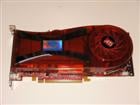Sapphire Radeon X1950 XTX
The GPU at the heart of the Sapphire Radeon X1950 XTX is of course ATI's R580+, which was first introduced on ATI's own Radeon X1950 XTX. The R580+ is similar to the R580 GPU used on earlier Radeon X1900 series cards, however, the "+" revision of the chip was re-spun to properly support the ultra-fast GDDR4 memory used on this card.
As we've mentioned in the past, the R580 GPU is comprised of approximately 380 million transistors and is built using TSMC's .09 micron manufacturing process. The GPU is outfitted with 48-pixel shader processors, 8-vertex shader processors, and a 256-bit 8-channel GDDR3/GDDR4 memory interface. The chip's internal Ring Bus memory controller operates at 512-bits, however.
Like ATI's own Radeon X1900 XTX and X1950 XTX cards, Sapphire's Radeon X1950 XTX has its core is clocked at 650MHz. And the 512MB of GDDR4 memory on the card is clocked at an impressive 1GHz (2GHz DDR). This boost to the memory clock results in a healthy 64GB/s of peak memory bandwidth. To help sustain these high clock speeds, the Sapphire Radeon X1950 XTX sports a segmented, copper cooler that is much quieter than the previous two-slot models used on older X1800 and X1900 cards.
The new cooler draws air in through a fan at the rear, blows air across the individual GPU and memory heatsinks, and then exhausts it out from the system. The fan is pushed back as far into the system as possible to minimize noise transmitted through the exhaust grate. While we're on the subject of the exhaust grate, right alongside it you can see the card's dual, dual-ling DVI outputs and HDTV output. The Sapphire Radeon X1950 XTX can power dual independent displays simultaneously, and the dual-link DVI outputs can drive all of the large flat panel displays currently available, like Dell's 3007WFP-HC for example.
















